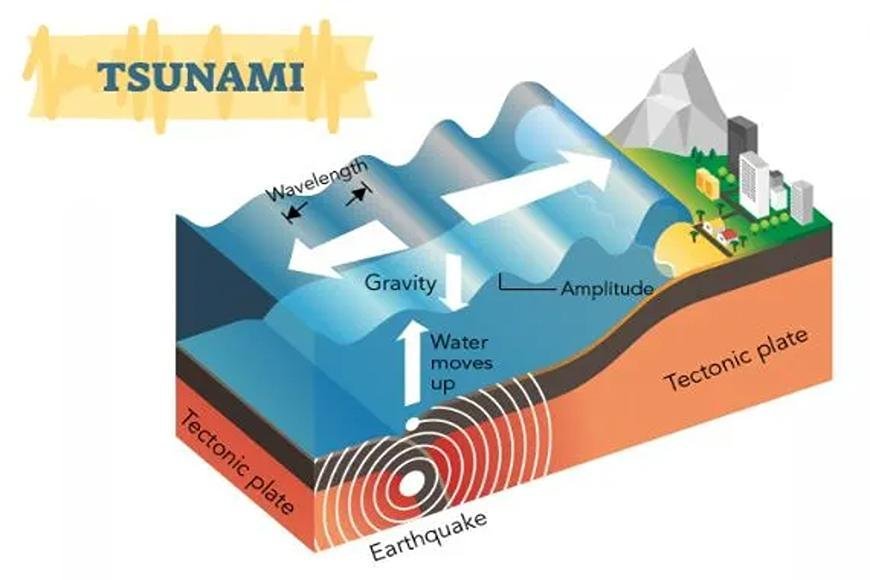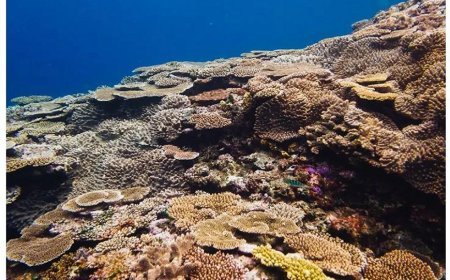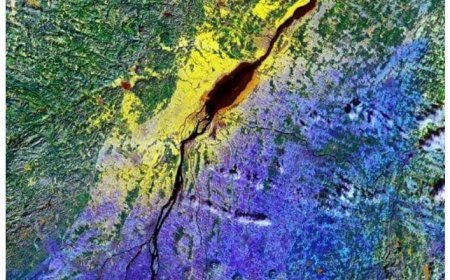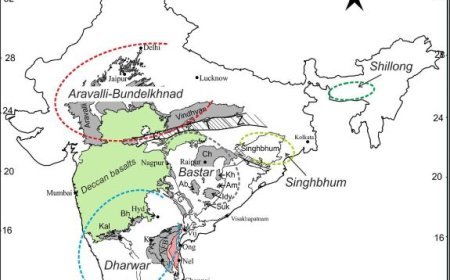EFFECTS OF TSUNAMI
Tsunamis reshape landscapes, leaving a lasting geological mark.

Tsunami
- The meaning of a tsunami says that it is "a set of waves caused by the movement of a large body of water in a body of water, usually an ocean or a large lake."
- Since the word "tsunami" means "wave," we can also call these things "tidal waves." Both tsunamis and tides move water inland, but the movement of water inland during a tsunami can be much greater, making what looks like a very high and strong tide called a tsunami wave.
Effects of the Tsunami
- So far, we've learned what a tsunami is and the different kinds of tsunamis. We will learn about the impact of the storm in this part.
- The damage a wave does to the coast can range from minor to major. The effects of a tsunami depend on the type of earthquake that caused it, how far away it is from where it started, how long it lasts, and finally, how the water depths are structured along the coast where the tsunami is coming from.
Let's talk about some of the terrible effects on people, animals, and nature.
Destruction
- It will do a lot of damage when it hits land.
- Tsunamis do damage in two ways: the hitting force of a fast-moving wall of water and the damaging strength of a large amount of water draining off the ground and carrying a lot of debris with it, even if the waves are small.
- When a big earthquake hits, the first wave is very high, but it doesn't do most of the damage.
- The sizable body of water behind the first wake is responsible for most of the damage.
- This is because the sea level keeps rising quickly, filling the coastal area.
- What kills and destroys is the force of the waves and the never-ending crashes of the water.
- The huge waves of a tsunami will kill anything that gets in their way as they hit the shore.
- Nothing is safe from tsunami waves. They destroy boats, homes, roads, cars, trees, power lines, telephone lines, and just about everything else in their way.
- If the tsunami waves have already destroyed the infrastructure along the shore, they will continue upstream for several miles, destroying more trees, houses, cars, and other things that people have built.
- Also, some of the small islands can't be found because of tsunamis.
Death
- One of the worst and most irreparable effects of a tsunami is the loss of life, since it is almost impossible to survive one. Many thousands of people die every year in tsunamis.
- Not much is known about a wave before it hits the ground. There is no time to plan a way out when the water is moving toward the shore.
- People who live near the coast, in cities, or in small towns don't have time to run away. The strong force of the wave kills right away, most of the time by drowning.
- Buildings falling down, electric shocks, and fires caused by gas, broken tanks, and floating objects are other things that kill people.
Disease
- The disease could spread in places hit by the storm because of flooding and dirty water.
- Malaria and other diseases can spread through water that doesn't move and is dirty.
- People will get sick and infections will spread quickly because it is hard to stay healthy and treat sickness in these places. This will cause more deaths.
- Damage to the environment: Tsunamis kill people, but they also kill animals, trees, insects, and natural resources.
- The land looks different after a storm. It pulls up trees and plants, as well as places where animals live, like bird nests.
- Animals on land die from drowning, and waste that washes into the sea and poisons marine life kills sea animals.
- A tsunami's effects on the environment are not limited to the scenery and animals; they also include human-made climate changes.
Tsunami Safety
- When a tsunami gets close to land, it becomes dangerous.
- When it gets into shallow water near the shore, its speed drops from 30 mph to 20 mph.
- The currents get stronger, the wavelength gets shorter, and the height goes up. There are different kinds of tsunami warnings.
- Local radio and TV stations, weather radios, wireless emergency alerts, and social media all send out tsunami warnings.
- You can also get them through outdoor sirens, text message alerts, city leaders, and phone calls.
- Instead of waiting for an official warning, it is better to listen for spontaneous tsunami alerts.
- Long, strong earthquakes, a loud sound from the ocean that sounds like a train or an airplane, and a quick rise or fall in the sea level that has nothing to do with the tide are some of these.
- Warnings from nature and the government are both very important. People should be ready to act quickly when these signs come up.
- People can get to a safe place by following the signs that say exit. No one should be able to do that, so they should go to high land or far from the coast.
- Tsunamis are less than 10 feet high when they hit land, but they can be over 100 feet high near their source.
- Some types of tsunamis look like walls of rough water or floods that rise quickly. Also, a big tsunami wave can do a lot of damage to low-lying shorelines.
- Water that is rushing because of storms, waves, or rivers is very strong. It can cleanse them of everything that is coming their way.
- Because of their size and speed, tsunamis do a lot of damage.
- When they come back from the sea with people, things, and trash on board, they become more dangerous.
- People are told to stay away from areas that could be hit by a storm until things get under control.
What's Your Reaction?



































